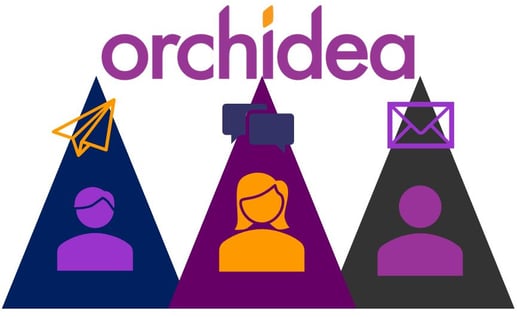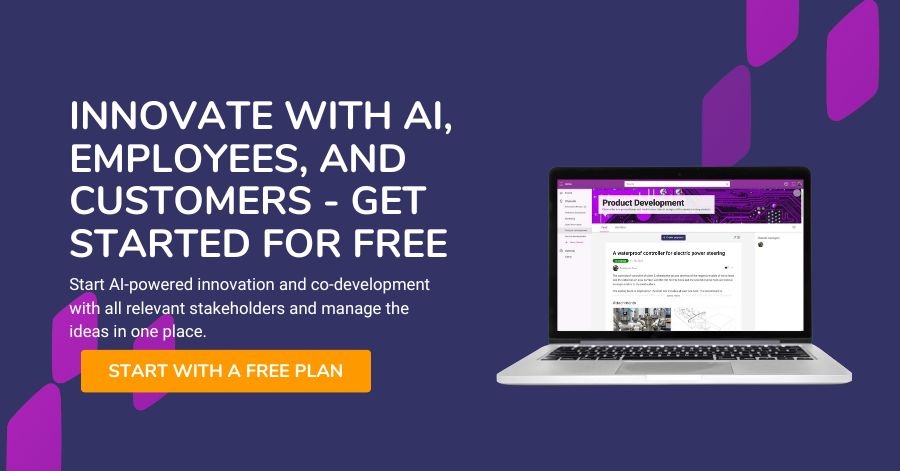An innovative company is creative and capable of renewal. Behind this now-so-common goal, the state is an ever-changing world that is ruthless for those who are standing still. Innovation programs are an important part of generating ideas in organizations. There are a few things you should consider in launching one to really succeed in it and make your innovation program effective.
An innovation program in this context means the activities and projects that an organization creates to develop new innovations, innovation culture, and innovation capabilities. In our opinion, innovation programs should be long-lasting, since changes in organizations tend to happen slowly.
Here we will share some practical advice on launching an innovation program. These tips are stemming from working with customers in this area and learning from their successes and mistakes.

Let’s concentrate on each of these steps in more detail.
1. Understand the current state
It is hard to change something you don't know what you are changing. Therefore, it is a good idea to drill into the current state of operations first in your innovation program launch. I recommend focusing on the following topics in the analysis:
- How do we view new ideas and the risks associated with them? Are we welcoming them and understanding that risk is a part of success or is the organizational culture focusing on risk avoidance?
- How do we react to failure?
- How customer-oriented are we?
- How have previous innovations been born? Have they been top-down or bottom-up projects? Which teams participated in them?
- In which projects have we failed? What can we learn from them?
- How do we make decisions?
- How well do we follow new trends and phenomena?
- What kind of expertise do we have?
It is important to look critically at the current state and define the phenomena that need to be changed in order for the desired change to succeed. It is good to set concrete goals for the change and include them in the goals of the whole project.
2. Align with business strategy and objectives
The innovation programs of a successful organization are well in line with business strategy and objectives. Ensuring this prevents the unfortunately common situation where ideas and initiatives that are perceived as good do not succeed when they do not align with business objectives.
By clearly informing the staff in advance of what types of ideas and innovations are we looking for, we can avoid the frustration born out of situations where ideas that are potential but align poorly with the organizational goals are not taken further.
It is important to set concrete measurable goals for the activity. Examples of commonly used objectives are:
- Number of ideas
- Number of ideas and projects approved or selected for further development
- The proportion of personnel involved in the innovation program
- Idea/project processing time
3. Pilot with the excited ones
Almost without exception, innovation programs are best spread throughout the organization by piloting them with the most enthusiastic units first. The reasons for this phenomenon are:
- Enthusiastic leaders inspire enthusiasm in their teams and demonstrate the importance of the program with their own example and participation.
- When participants are enthusiastic and positive towards the program, the shortcomings and mistakes that take place often in the pilot are not fatal for the program. On a smaller scale, it is also easier and faster to take corrective action.
- In enthusiastic units, the implementation of the best ideas happens quickly, which creates a positive cycle of participation.
- As the news about the success of the program spreads, other teams and units outside the pilot are getting eager to join in.
If there are no truly enthusiastic units interested in piloting, there is a need to critically evaluate the management's commitment to the project and the meaning of continuing the project.

4. Seek commitment from managers
The managers and superiors of the organization can significantly influence the enthusiasm of the personnel to participate in the program. It is important to assure that they know why the organization has decided to start the innovation program. They should be given examples of how they can help in the program. At the same time, it is useful to demonstrate behaviors that can be harmful to success.
The opinions of key stakeholders should be considered when planning the operating model and piloting. People are typically more committed to change once they have been able to influence how it is implemented. This is especially important in a large organization if the program is driven from headquarters. If the units feel that their voice was not heard in the preparation, the program has a very high risk of failure.
At the same time, you should review the objectives of leaders and managers and ensure that they do not conflict with the goals of the program. For example, in a business where staff is servicing customers on a time and material basis, it is important to create a mechanism that allows them to participate without their billing rate being affected.
5. Integrate into existing models
It is important to integrate the activities into the current operating model and try to avoid creating processes dedicated exclusively to innovation activities. Here are some examples of integration:
- Decision-making will be integrated into existing development decision-making. Decisions on smaller ideas are made within the existing organizational structure.
- Rewarding follows the organization’s general policies and the goals for the innovation program are part of the annual goals.
- Ideas that are not implemented after the review process are stored in the idea bank and are reviewed whenever an existing product, service, or process is developed. The implementation of ideas is much easier and more cost-effective to do simultaneously with other development activities like product
- The tools chosen for the innovation program such as innovation challenges, brainstorming sessions, and workshops, are utilized in annual planning and when starting new projects.
- The monitoring of innovation program key performance indicators happens regularly for example in quarterly reviews and management meetings.
Generally, there is a need to create a process for collecting and processing ideas, or the current process needs to be modified to support idea creation. By studying the emergence of innovations, we have learned that ideas develop into higher quality when they are discussed and sparred.
At the same time, a broader commitment to the idea emerges in the organization when people have been able to express their own views in the discussion. For this reason, after registering the idea, it is a good idea to try to involve the staff in the collaborative development of the idea.
Things to consider when defining the innovation process are:
- An open operating model in which all information is visible to users increases confidence and creates positive pressure for progress as users can check the status of the ideas generated from the innovation software.
- A simple operation model works usually the best. A complex and bureaucratic operating model may look good on paper but makes the operation easily difficult and extends the processing time. If a need to develop the process is noticed during the pilot, it is easy to do and more likely based on the real need.
- Decisions about ideas should be made by the people responsible for the implementation. In this case, they are able to realistically assess the suitability of the idea compared to other development projects and the existing workload.
- Typical steps of the idea process are:
- Idea collection and conversational co-development
- Expert review of numerical evaluation
- Further development of selected high-potential ideas
- Decision-making
Read more about the idea process in our blog post What is Idea Management and How to Do It?.
6. Create motivation to participate
According to an innovation study, the main reasons for a member of the staff to submit an idea are:
- the frustration of employees with work processes and desire to change them (23.2%)
- desire to improve the success of the organization (18.1%)
- desire to save money from the organization (17.9%)
- personal satisfaction (10.7%)
- money / gifts (9.7%)
Based on the research, it is easy to see that the main emphasis in motivating the staff should be on internal motivators. Based on Orchidea's experience, the most important thing in keeping the participants motivated is to recognize active participants, relevant ideas, and good results. The valuable input of people managing the idea process and reviewing them is also good to keep in mind when planning acknowledgments.
An excellent example of a symbolic acknowledgment is the wooden coins shared by Colgate-Palmolive’s product development. They were given to people who contributed to the success of the projects. It became customary for the recipients not to keep the coins to themselves but to distribute them to people who had helped them.
If innovations are rewarded in monetary terms, in our experience, the rewards should be linked to the real benefits of implementation. In the study of the Lappeenranta University of Technology on internal crowdsourcing, the transparency of rewards and the above-mentioned public acknowledgment played an important role. According to the study, the fairness of the reward was also important for the staff.

7. Plan
Once the issues discussed in sections 1 to 6 of this list have been completed, it is a good idea to draw up an action plan. It includes the following items and their timetable:
- Launch event
- Schedule and topics for planned events like innovation challenges, workshops, boot camps, pitching events, etc.
- Plan for rewarding and acknowledgments
- Communication plan
- Training plan
- Monitoring of key performance indicators
- Regular follow-up meetings of the group in charge of the program
8. Launch
You should schedule the launch so that there are no long holiday periods coming in the following months. Otherwise, there is a risk that participation will be low as the staff focuses on finishing their projects before the holidays. And during the holidays, the new initiative would be easily forgotten and therefore it should be relaunched straight after the holidays.
As I wrote at the beginning, in a large organization, it is advisable to pilot for 2-3 months among the excited ones. Based on the piloting, the shortcomings of the operation model can be fixed, and the participants of the pilot can act as an internal reference when expanding the operation. If you are using innovation software for collecting ideas, piloting will also make it easier for new users to participate because it is already contained in the software.
The program should be launched visibly to the participants, using all possible communication channels. It is not enough to add news to the intranet and send one e-mail for the launch.
Here are examples of successful innovation program launches:
- A launch is a separate event or a part of a monthly or quarterly meeting. At the same time, a challenge or campaign will be launched with prizes.
- The innovation team visits team meetings to talk about the program.
- A goal for the number of ideas / proposals / projects / workshops in the first month is set and the progress towards the goal is communicated regularly.
- The program team follows new ideas and discussions and rewards active participants with quick prizes. The internal communication team makes short news about the rewarded ones.
- A piece of the puzzle of the innovation programs’ logo has been given to each employee's desk / locker / location on the morning of the launch. By finding colleagues with compatible pieces and taking them together to a café, everyone gets a cake or coffee.
- At the launch, an innovation challenge related to a strategically important topic is published.
- The first ideas after the launch are processed and implemented particularly quickly. The news will be written about the implementations and received
9. Lead by example
The leaders and managers in the organization play a big role in shaping the culture. Culture is shaped by what people do and don’t do, so leading by example is important. If the management only talks about the importance of innovation without walking the talk, the results might be inferior.
Concrete ways to set an example are:
- Advancing approved ideas and projects of ideas quickly.
- Inviting the best inventors to present their ideas and projects to the senior management team.
- The KPIs of the innovation program are reviewed in quartally meetings with other key business figures.
- Managers bring up ideas in team meetings and the ideas will be further developed together.
- The assistant of the senior management team makes sure that each member of the senior management team comments on the ideas that have been submitted in the innovation challenge.
- The members of the senior management team participate in the project meetings of innovation projects.
- Managers remind about the program and the need for new ideas in their team meetings.
- The program team discusses actively submitted new ideas and invites relevant colleagues to the discussion
10. Make decisions
One of the most effective ways to accelerate or slow down change in an organization is decision-making. A great example of the successful use of this catalyst was given by a product development director who launched a new funding model for radical innovation projects. He said the first idea to apply for funding was by no means special, but he still gave it immediate funding because he wanted to message the organization about his desire to try out all sorts of new approaches.
In the previous example, the role of decision-making in change management is well internalized: in the first years of the innovation program, the decision making criteria should be 50% on change management and 50% on process outcomes, i.e. innovation itself.
It is natural that most projects fail and only a small proportion, usually less than 10%, succeed. Therefore, the innovation process should be such that as many potential ideas as possible are tested quickly with customers in a low-cost experiment. Development work should continue with the ideas that emerged from the experiments as winners.
Writing long business plans is ill-suited for this type of agile experiment model. It is worth considering carefully what type of presentation or plan is required of the presenters of ideas. In practice, it is often more efficient to spend 2-3 days testing an idea with customers than writing a 20-page business plan.
11. Communicate, communicate, communicate
After the launch of the innovation program, regular communication plays an important role in keeping the new activity in the minds of the personnel. In communication, you should use all the channels commonly used in the organization, such as e-mail, intranet, events, chat, and team meetings.
Topics to be raised in communications include e.g.
- Employees acting in an exemplary and desirable manner in relation to the goals of the program
- Rewarded individuals
- News about the implemented ideas / project and the benefits derived from them
- Information about upcoming events such as challenges or workshops
- Interesting ideas, their inventors, and stories related to how the idea was born
- Introductions of people involved in the program
Of course, reviewing the program result should be also part of regular operations reviews of the organization, such as quarterly meetings or CEO's reviews.

12. Monitor and develop
We recommend piloting the program with a simple and straightforward operations model. One of the goals of the piloting is to gather feedback and modify the operating model based on it. Therefore, it is a good idea to meet regularly with the innovation team and review the status of the operations. The meeting should cover at least the following topics:
- General discussion of the situation
- Monitoring of the program launch plan
- Monitoring of KPIs
- Possible corrective action
The development of the operations model can be implemented by launching a dedicated innovation challenge or idea collection channel for the duration of the pilot. It is also important for program team members to submit their own improvement proposals to them and set an example of an open co-development approach.
Conclusion
Launching an innovation program isn’t rocket science, but it definitely is a process with important issues to keep in mind. You must have a plan and be active about it to really succeed in your launch.
By following these steps, you’ll hopefully launch a successful innovation program. Just remember to pay attention to every step and explore the best ways to operate in your organization. If you have launched an innovation program or have something to add to these tips, share your thoughts in the comments below.
Good luck with your innovation program launches!
Orchidea is a versatile innovation tool that has solutions for all your innovation activities from brainstorming with a small team to crowdsourcing. Collect ideas from all relevant stakeholders through permanent channels or with campaigns like innovation challenges and digital workshops.






.jpg)

